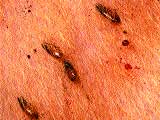Developing integrated flea control for cats
Dr. Michael Dryden tackles the difficult to task of controlling flea infestations in cats through an intergrated approach to prevention.
Attempting to eliminate fleas on cats can be expensive, time-consuming and occasionally hazardous to your health. Historically administration of flea treatments to cats involved sprays, shampoos, powders and dips. Most cats find these application methods offensive, and they tended to react defensively. Luckily for cats and their owners, the development of easily-administered topical and systemic therapies has greatly facilitated application and regular compliance.

Cat with severe flea allergy dermatitis.
Flea species associated with catsand their medical implications
While several flea species have been found on cats in North America, only Ctenocephalides felis felis, the cat flea, occurs with enough regularity to be of considerable importance. The cat flea is the cause of severe irritation in cats, being responsible for the production of allergic dermatitis. The cat flea can also serve as the vector of typhus like rickettsia and is the intermediate host for filarid and cestode parasites.
Flea allergy dermatitis is an immunologic disease in which a hypersensitive state is produced in a host as a result of the injection of antigenic material from the salivary glands of fleas. The condition is found worldwide and is a major cause of feline miliary dermatitis. Since fleas feed exclusively on the blood of their host they can cause iron deficiency anemia or even death in heavy infestations. Murine typhus, caused by the organisms Rickettsia typhi and R. felis, is a febrile disease characterized by development of headaches, chills and skin rashes, with infrequent involvement of the kidneys and central nervous system. The cat flea is now a recognized vector of this disease in the United States. Dipylidium caninum, the common intestinal tapeworm of cats, develops as a cysticercoid in the cat flea. The cat flea is now considered the vector of Bartonella henselae among cats. Bartonella henselae is the causative agent of cat scratch disease in humans.
Flea migration
Once cat fleas acquire a host they feed rapidly, mate and begin egg production within 24 to 48 hours. Cat fleas remain on the host, laying 40 to 50 eggs per day within the pelage. Shortly after deposition eggs fall out of the hair coat and are distributed into the premises anyplace the flea-infested cat has access. Adult cat fleas are considered permanently host-associated ectoparasites. Since reproduction occurs on the cat, interruption of reproduction can be accomplished on the cat.
Most insecticides do an excellent job of eliminating existing fleas from the cat during the initial application. The problem is that reinfestation is a common occurrence. Historically, flea control was achieved through repeated application of short-acting, on-animal products and application of insecticides and insect growth regulators into the premises (IGRs). These programs were designed to kill existing fleas on the cat and reduce populations of developing and emerging adult fleas in the surrounding environment. The difficulty with this approach was getting cat owners to consistently follow treatment protocols. Because cat owner compliance was often poor, cats repeatedly acquired new fleas from the premises and infestations became a recurring problem.
The recent development of easily administered insecticides and IGRs with prolonged residual activity, have improved dramatically cat owner compliance and have helped to eliminate recurrent infestations.
Several of these new insecticides and IGRs have even been shown to be extremely effective in eliminating flea infestations in even the most difficult climatic conditions. Studies conducted in private residences in Tampa, Fla. demonstrated that regular administration of fipronil (Frontline"Top Spot‰; Merial Animal Health), imidacloprid (Advantage‰ Flea Adulticide), and lufenuron (Program®; Novartis Animal Health) + nitenpyram tablets (Capstar‰ Novartis Animal Health), and selamectin (Revolution® Pfizer Animal Health) were extremely effective in eliminating established flea populations within 60 to 90 days, without the need to treat the premises.

Continued reproduction must stopped in order to prevent persistent flea infestations and selection for resistant fleas.
These products work effectively at eliminating infestations because they either kill fleas prior to initiation of reproduction or reproduction is directly inhibited. While providing the cat immediate relief from fleas is one aspect of treatment, the other goal should be eliminating fleas before they can lay eggs. If flea products containing fipronil, imidacloprid or selamectin are be applied to cats at the prescribed dose and treatment interval there should be adequate residual activity for the next 30 days to kill most if not all newly acquired fleas within 24 to 48 hours before egg production begins. However, flea survival and reproduction do occasionally occur between applications. Infrequent product application occasionally occurs because of simple lack of compliance with label or veterinary instructions. While the inability of many cat owners to adequately apply traditional formulations has in large part been overcome with these new products, misapplication and therefore under-dosing does still occur. In addition, genetic variability of different flea populations means that none of these residual flea products are 100 percent effective against all cat flea strains between labeled reapplication periods.
Double duty
Since none of these residual adulticides are 100 percent effective throughout their labeled duration of activity and compliance problems do still occur, surviving fleas often are capable of producing viable eggs. Continued reproduction must be halted in order to prevent persistent flea infestations and selection for resistant fleas. The reproductive process can be directly prevented by administration of topical IGRs such as methoprene and pyriproxyfen. The use of topical IGRs provides for prolonged residual ovicidal activity, interrupting future flea development, even after residual activity of an insecticide is diminished. Not only have topical applied IGRs been shown to be ovicidal, but oral and injectable lufenuron also produces prolonged inhibition of egg viability. While not an IGR, selamectin also provides prolonged ovicidal activity. Lufenuron, methoprene, pyriproxyfen and selamectin can all provide pronounced activity against egg viability, virtually ensuring destruction of flea populations.
While the combined approach of an adulticide and IGR may hold considerable promise, it must be remembered the use of mechanical control procedures should still be an essential part of flea control. The cat owner should wash the cat's blanket, throw rugs and cat carrier, in addition cat sleeping and resting areas should be vacuumed thoroughly to help remove flea eggs and larvae. Seat cushions and pillows on sofas and chairs should be removed and vacuumed, and special attention should be given to crevices in sofas and chairs and to areas beneath sofas or beds where flea eggs and feces may drop from the cat and accumulate. Additionally, the screening of foundation vents and porches to keep pests, rats, opossum, squirrels and other flea hosts out from under the house can be of benefit.

To prevent reinfestation of fleas, pet owners should thoroughly wash a cat's blanket, rugs and other items it uses. It also a good idea to vacuum seat cushions and pillows of couches and chairs to help remove flea eggs and larvae.
As demonstrated these new compounds can eliminate flea populations without the need for premise treatments. However, in cases of massive in-door infestations or severe allergy, applications of adulticides and IGRs into the premises may be necessary.
Suggested Reading
- Dryden M, Maggid-Denenberg T, Bunch S, Schenker R. Control of Fleas on Dogs and Cats and in Private Residences with the Combination of Oral Lufenuron and Nitenpyram. Vet Therapeutics 2:208-214, 2001.
- Jacobs DE, Hutchinson MJ, Ryan WG. Control of flea populations in a simulated home environment model using lufenuron, imidacloprid or fipronil. Med Vet Entomol. 15:73-7, 2001.
- Rust MK, Dryden MW. The biology, ecology and management of the cat flea. Ann. Rev. Entomol. 42:451-473, 1997.
- Payne PA, Dryden MW, Smith V, Ridley RK. Effect of 0.29% w/w fipronil spray on adult flea mortality and egg production of three different cat flea, Ctenocephalides felis (Bouche), strains infesting cats. Vet Parasitol. 102:331-40, 2001.
- Ritzhaupt LK, Rowan TG, Jones RL.Evaluation of efficacy of selamectin and fipronil against Ctenocephalides felis in cats. J Am Vet Med Assoc. 217:1666-8, 2000.